Books in English by Shinsaku Fujita
[Books in Japanese]
[History]
[Fujita's Home Page]
List of Books
[Fujita's Home Page]
Books
[Home Position in Top of Index]
Bibliographic Data
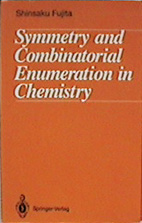
- Title:
Symmetry and Combinatorial Enumeration in Chemistry
- Author:
Shinsaku Fujita
- Publisher:
Springer-Verlag
- Address:
Berlin-Heidelberg-New York
- Year:
1991
- Pages:x+368
- ISBN:3-540-54126-8, 0-387-54126-8
- Language:English
- Remarks:
Summary
368 pages containing 21 chapters and appendices.
In contrast to traditional textbooks on chemical
symmetries based on linear representations and irreducible representations,
this book has discussed molecular symmetries in terms of
permutation representations and coset representations.
This approach (the unit-subduced-cycle-index approach) provides us
with versatile tools by which molecular symmetries and combinatorial
enumeration of isomers can be discussed on a common basis. In particular,
four distinct but relevant methods of combinatorial enumerations
developed by the author have been discribed in detail.
Table of Contents
- Introduction
- Symmetry and Point Groups
- Permutation Groups
- Axioms and Theorems of Group Theory
- Coset Representations and Orbits
- Systematic Classification of Molecular Symmetries
- Local Symmetries and Forbidden Coset Representations
- Chirality Fittingness of an Orbit
- Subduction of Coset Representations
- Prochirality
- Desymmetrization of Para-Achiral COmpounds
- Topicity and Stereogenecity
- Counting Orbits
- Obligatory Minimum Valencies
- Compounds with Achiral Ligands Only
- New Cycle Index
- Cage-Shaped Molecules with High Symmetries
- Elementary Superposition
- Compounds with Achiral and Chiral Ligands
- Compounds with Rotatable Ligands
- Promolecules
- Appendix A. Mark Tables
- Appendix B. Inverses of Mark Tables
- Appendix C. Subduction Tables
- Appendix D. Tables of USCIs
- Appendix E. Tables of USCI-CFs
- Index
Additional Data
Coset representations are related to the stereochemical nature
of organic and inorganic molecules, where a new concept
"chirality fittingness" (or sphericity) has been proposed.
Another new concept "subduction of coset representations"
is proposed so as to develop four methods of combinatorial
enumerations (USCI methods), which have been
applied to various combinatorial enumerations.
A book review by C. Alden Mead has appeared in
Journal of the American Chemical Society (1992, 114, 4018--4019).
A part of the review is cited below:
"This book is not so easy going, but the reader who makes the
necessary effort will be rewarded by the acuisition of some
powerful tools and deep insights.
If the coming generation of chemists becomes as familiar with
mark tables and their uses as the present generation is
with character tables, much of the credit will go to
Fujita and the present book."
[Additions and Corrections]
[Top of Index]
[Home Position in Top of Index]
[Home Position in Top of Index]
Bibliographic Data
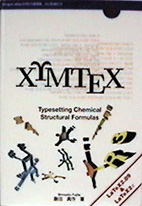
- Title:
XyMTeX---Typesetting Chemical Structural Formulas---
- Author:
Shinsaku Fujita
- Publisher:
Addison Wesley Publishers Japan
- Address:
Tokyo
- Year:
1997
- Pages:xii+352
- ISBN:4-7952-9701-0
- Language:English + Japanese
- Remarks:CD-ROM Attached
Summary
This book on the XyMTeX system developed by the author
contains a reference manual, introductory remarks, and
examples. The CD-ROM attached to this book involves
the XyMTeX system and the OzTeX system.
Table of Contents
- Features and Scope
- Feature of XyMTeX
- Scope of XyMTeX
- References
- Reference Manual
- Introduction
- The Construction of XyMTeX
- Six-Membered Carbocycles
- Carbocycles with Fused Six-Membered Rings
- Fused Tricyclic Carbocycles and Steroids
- Five- or Lower-Membered Carbocycles
- Six-Membered Heterocycles
- Five- or Lower-Membered Heterocycles
- Heterocycles with Fused Six-to-Six-Membered Rings
- Heterocycles with Fused Six-to-Five-Membered RIngs
- Building Blocks
- Further Cyclic Compounds
- Aliphatic Compounds
- Combining structures
- Large Substituents
- Polymers
- Chemical Environments
- Reaction Schemes
- Boxes
- References
- Appendix A. List of Commands
- Introduction of XyMTeX (in Japanese)
- Introduction
- Drawing Benzene Derivatives
- Drawing Cyclohexane Derivatives
- Adjusting Positions of Substituents
- Drawing Pyridine Derivatives
- General Methods for Drawing Heterocycles
- XyMTeX Command LaTeX Commands
- References
- XyMTeX by Example (in Japanese)
- Introductions
- Basic Tachiques
- Chemistry Environment
- Examples
- References
- Closing Remarks and Appendices (in Japanese)
- Closing Remarks
- Contents of CD-ROM
- Indices
- Index (English)
- Index (Commands)
- Index (Japanese)
Additional Data
Structural formulas by the XyMTeX system are
based on the typesetting technique in
contranst to popular drawing software.
[Top of Index]
[Home Position in Top of Index]
[Home Position in Top of Index]
Bibliographic Data
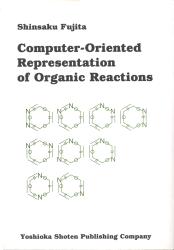
- Title:
Computer-Oriented Representation of Organic Reactions
- Author:
Shinsaku Fujita
- Publisher:
Yoshioka Shoten
- Address:
Kyoto
- Year:
2001
- Pages:x+371
- ISBN:4-8427-0295-8
- Language:English
- Remarks:
Summary
371 pages containing 16 chapters and an index.
Organic materials of various functions are important factors
to enrich our modern life. It is crucial for us to enhance
their usefulness on one hand and to minimize their undesirable
effects on the other hand. Thus we should control synthetic processes
of useful materials, their behaviors under natural and artificial
conditions, and decomposition processes of used materials.
These tasks require our knowledge on changes of such organic materials,
where accumulated items on the changes are systematized
so as to realize a well-constructed database of organic reactions.
This book deals with a computer-oriented representation of
organic reactions in the light of the concept of imaginary
transition structure (ITS) proposed by the author.
The concept provides us with a versatile methodology to describe,
classify, and enumerate organic reactions; and enables us
to construct and retrieve an organic-reaction database efficiently.
Table of Contents
- Introduction
- Imaginary Transition Structures
- Even-Membered Cyclic Reaction Graphs
- Spiro Reaction Graphs
- Fused Reaction Graphs
- Formal Charges and Three-Dimensional Structures
- Odd-Membered Cyclic Reaction Graphs
- Odd-Nodal Subgraphs
- Even-Nodal Subgraphs
- Imaginary Rings
- Essential Set of Essential Rings
- Linear Coding of Individual Organic Reactions
- Linear Coding of Reaction Types
- Enumeration of Reaction Graphs
- Enumeration of Reaction-Center Graphs
- Synthetic Pathways
- Index
Additional Data
The publication of this book was supported by
Japan Society for the Promotion of Science: Grant-In-Aid
for Publication of Scientific Research Results (No. 135305, 2001).
[Top of Index]
[Home Position in Top of Index]
[Home Position in Top of Index]
Bibliographic Data

- Title:
Organic Chemistry of Photography
- Author:
Shinsaku Fujita
- Publisher:
Springer-Verlag
- Address:
Heidelberg Berlin
- Year:
2004
- Pages:xiv+587
- ISBN:3-540-20988-3
- Language:English
- Remarks:
Summary
587 pages containing 21 chapters and an index.
In conventional color photography, spectral sensitizers cooperate with silver halide
as acceptors of light during the exposure process, color developers reduce
silver halide grains during the developing process, and finally the resulting
oxidized developers react with couplers to form imaging dyes. Instant color photography
gives us an alternative way of realizing excellent color reproduction, in which dyes changing
their diffusibility play an important role. The aim of this book is to provide researchers and
graduate students with a perspective on how such organic compounds work in color photography
and how seemingly miraculous techniques based on organic chemistry lead to color images of
high quality. The readers will acquire the philosophy and learn from hints on how to develop
functionalized organic compounds.
Table of Contents
- I. Fundamentals of Photography.
- Photography Based on Silver Halides. An Overview.
- Photographic Emulsions.
- Silver Halide Crystals. Fundamental Properties.
- Silver Halide Crystals. Photo-Sensitivity.
- Photographic Development and Developers.
- II. Principles of Color Photography.
- Color Reproduction.
- Spectral Sensitization and Sensitizing Dyes.
- III. Chromogenic Photography.
- History of Color Development.
- Color Developers.
- Couplers.
- Two-Equivalent Couplers.
- Colored Couplers.
- DIR Couplers and Related Compounds.
- DIR Hydroquinones and Related Compounds.
- IV. Diffusion Transfer Photography.
- Silver-Salt Diffusion Transfer Photography.
- Chemistries in Instant Color Photography.
- Dye Developers.
- p-Sulfonamidonaphthol Dye Releasers.
- o-Sulfonamidophenol Dye Releasers.
- Positive-Working Dye Releasers.
- V. Dye Bleach Photography.
- Silver Dye Bleach Photography.
- Index
Additional Data
A book review
by M. W. Taush
published in Angew. Chem. Int. Ed., 44, 2629 (2005).
[Top of Index]
[Home Position in Top of Index]
[Home Position in Top of Index]
Bibliographic Data
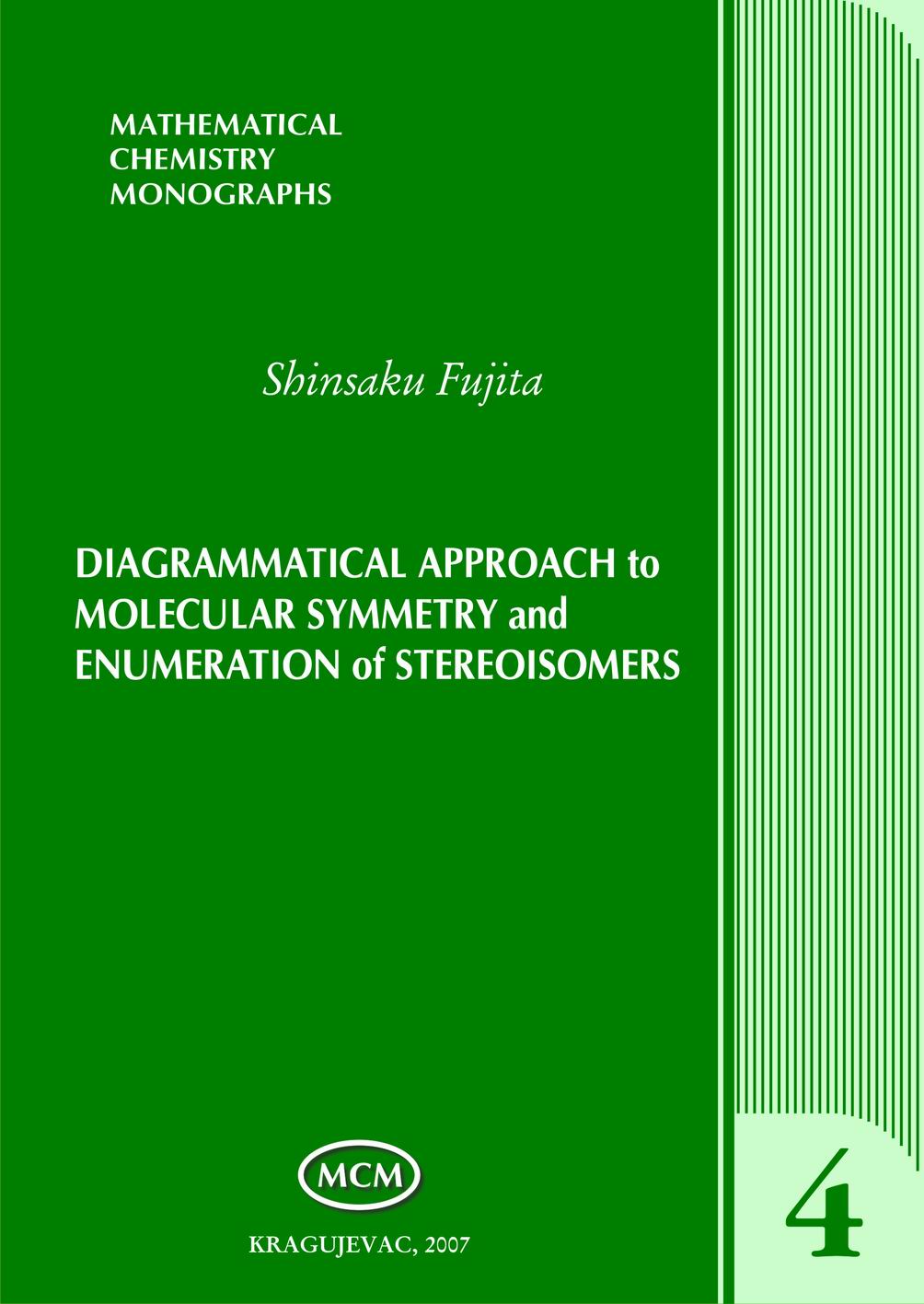
- Title:
Diagrammatical Approach to Molecular Symmetry and Enumeration of
Stereoisomers
- Author:
Shinsaku Fujita
- Publisher:
University of Kragujevac, Faculty of Science
- Address:
Kragujevac
- Year:
2007
- Pages:x + 206
- ISBN:978-86-81829-75-2
- Language:English
- Remarks:
Summary
206 pages containing 8 chapters and an index.
Table of Contents
- Introduction
- Stereochemistry and Stereoisomerism
- Chemical Group Theory
- Graph Theory and Chemical Combinatorics
- Mathematical Stereochemistry
- Molecular Symmetries and Point Groups
- Symmetries of Molecules
- Point Groups Based on a Methane Skeleton
- Point Groups Based on an Adamantane Skeleton
- Chirality and Achirality
- Subgroups and Cosets
- How to Characterize Molecular Symmetries
- Summary of This Chapter
- Symmetries in Molecules and Sphericity Indices
- Desymmetrization of the Tetrahedron
- Orbits as Equivalence Classes
- Concurrent Desymmetrizations of Orbits
- Change of Sphericities
- Summary of This Chapter
- Local Symmetries and Sphericities
- Proligands and Ligands
- Orbits and Coset Representations
- Desymmetrization of Molecules
- Sphericities of Orbits and Sphericity Indices
- Symmetry Fittingness for Matched and Mismatched Molecules
- Summary of This Chapter
- Sphericities vs. Topicities
- Relationships vs.\ Orbits (Equivalence Classes)
- Conventional Stereochemical Terminology
- New Stereochemical Terminology
- Methane Derivatives
- Adamantane Derivative
- Summary of This Chapter
- Intramolecular Stereochemistry
- Symmetries and Point Groups for Allene
- Orbits and Sphericities
- Right and Left Coset Representations
- Exhaustive Diagrammatical Derivation of Coset Representations
- Mathematical Models into Chemical Structures
- Subductive Derivation
- Diagrammatical Derivation of Subductions of RCRs
- Diagrammatical Correspondence Between Segments and Cosets
- Summary of This Chapter
- Intermolecular Stereochemistry
- Correspondence Between Right and Left Cosets
- Stereoisomerism
- Subductions of Orbits of Assemblies
- Mandalas as Nested Regular Bodies
- Intermolecular and Intramolecular Stereochemistry
- Mandalas, Assembled Mandalas, and Reduced Mandalas
- Summary of This Chapter
- Enumeration of Stereoisomers
- Integration of Intra- and Intermolecular Stereochemistries
- Fixed-Point Vectors as Ordered Sets of Marks
- Combinatorial Enumeration
- Perspectives
- Summary of This Chapter
[Top of Index]
[Home Position in Top of Index]
[Home Position in Top of Index]
- Bibliographic Data
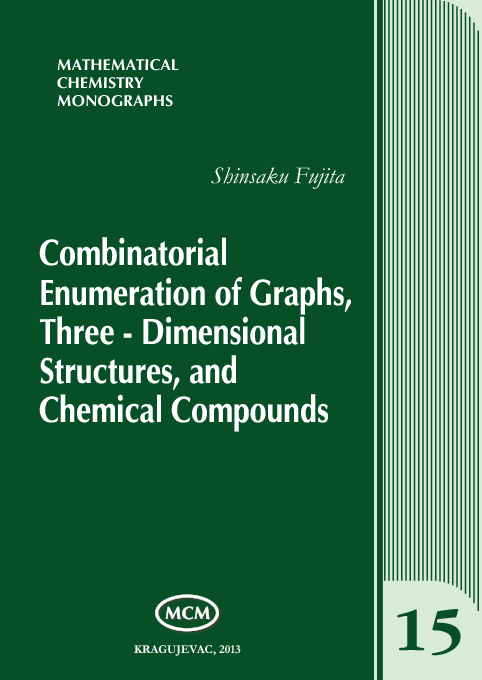
- Title:
Combinatorial Enumeration of Graphs, Three-Dimensional Structures,
and Chemical Compounds
- Author:
Shinsaku Fujita
- Publisher:
University of Kragujevac, Faculty of Science
- Address:
Kragujevac
- Year:
2013
- Pages:xiv + 576
- ISBN:978-86-6009-020-3
- Language:English
- Remarks:Mathematical Chemistry Monographs Vol. 15
- Contents
576 pages containing 13 chapters, 2 appendices, and an index.
- Introduction, 1
- Historical Backgrounds, 1
- Key Concepts for the USCI Approach, 6
- The USCI Approach for Combinatorial Enumeration, 14
- References, 16
- USCI Approach, 19
- Characters and Marks, 19
- Coset Representations, 20
- Vector Space of Marks, 28
- Subductions of Coset Representations, 33
- Symmetry-Itemized Enumeration, 37
- Gross Enumerations, 45
- References, 51
- Markaracter Method, 53
- Dominant Representations, 53
- Non-Dominant Representations, 67
- Maximum Chiral Subgroups, 77
- Combinatorial Enumeration Based on Markaracters, 84
- Illustrative Examples of the Markaracter Method, 102
- References, 112
- Characters, \bfQ -Conjugacy Characters, and Markaracters, 113
- Linear Representations and Characters, 113
- \bfQ -Conjugacy Representations and \bfQ -Conjugacy Characters, 141
- Markaracters and {\bf Q}-Conjugacy Characters, 156
- References, 168
- \bfQ -Conjugacy Characters and Markaracters for Cyclic Groups, 169
- {\bf Q}-Conjugacy Representations of Cyclic Groups, 169
- {\bf Q}-Conjugacy Character Tables for Cyclic Groups, 174
- Markaracter Tables for Cyclic Groups, 178
- Amplificative Equivalences and Number-Theoretic Vectors, 181
- Tables for Several Cyclic Point Groups., 189
- References, 192
- Characteristic-Monomial Method, 193
- Characteristic Monomials, 193
- Characteristic-Monomial Method for Enumeration, 218
- Illustrative Examples of the Characteristic-Monomial Method, 230
- References, 236
- Proligand Method, 237
- P\'{o}lya's theorem vs. Fujita's Proligand Method, 237
- Sphericities of Coset Representations for Cyclic Subgroups, 239
- Sphericities of $k$-Cycles, 242
- Comparison of Fujita's Proligand Method with P\'{o}lya's Theorem, 261
- Illustrative Examples of Fujita's Proligand Method, 264
- References, 271
- Extended-Superposition Method, 273
- Generating Functions vs. Superpositions, 273
- Elementary Superposition, 274
- Superposition, 282
- Extended Elementary Superposition, 290
- Extended Superposition, 303
- References, 310
- Double Cosets with Sphericities and the Double-Coset Method, 311
- Historical Backgrounds, 311
- Right and Left Coset Representations, 312
- Subduction of Coset Representations and Double Cosets, 317
- Sphericities of Double Cosets for Cyclic Subgroups, 322
- Combinatorial Enumeration Based on Double Cosets, 330
- References, 336
- Double-Coset-Representation Method, 337
- Double Coset Representations, 338
- Combinatorial Enumeration, 359
- Illustrative Example for Surveying Practical Steps, 363
- References, 367
- Enumeration of Non-Rigid 3D Structures, 369
- Graphs vs.\ 3D Structures---Revisited, 370
- Proligand Approach for Enumerating Non-Rigid 3D Structures, 372
- P\'{o}lya's Corona as a Degenerate Case of Fujita's Proligand Approach, 397
- Generalization of Extended CI-CFs, 407
- References, 416
- Monosubstituted Alkanes as Planted Three-Dimensional Trees, 417
- Historical Backgrounds, 418
- Planted Trees in Graph Theory, 419
- Planted Three-Dimensional Trees, 432
- Numbers of Asymmetric and Pseudoasymmetric Centers, 458
- References, 477
- Alkanes as Three-Dimensional Trees, 479
- Centroidal and Bicentroidal Three-Dimensional Trees, 479
- Alkanes as Constitutional Isomers and as Steric Isomers, 482
- Alkanes as 3D-Structural Isomers, 488
- Graphs (Trees) vs.\ 3D Structures (3D-Trees) for Alkanes, 507
- Effects of Asymmetric and Pseudoasymmetric Centers, 512
- References, 535
- Appendix A: Terminology for Isomerism and Stereoisomerism, 537
- Graphs and Three-Dimensional Structures, 537
- Conventional Terminology, 538
- Terminology for Combinatorial Enumeration, 542
- Further Endeavors, 544
- References, 544
- Appendix B: Properties of Inverse Mark Tables, 545
- Proof of Theorem 2.8, 545
- Proof of Theorem 2.10, 550
- Row Sums for Respective Columns of the Inverse Mark Table, 555
- References, 555
- Index, 557
- [Additions and Corrections]
[Top of Index]
[Home Position in Top of Index]
[Home Position in Top of Index]
- Bibliographic Data
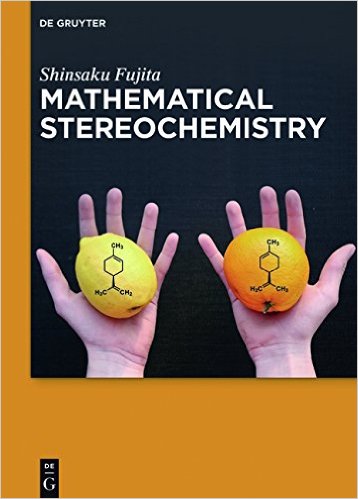
- Title:
Mathematical Stereochemistry
- Author:
Shinsaku Fujita
- Publisher:
De Gruyter
- Address:
Berlin
- Year:
2015
- Pages:xviii + 437
- ISBN:978-3-11-037197-0
- Language:English
- Remarks:
- Contents
437 pages containing 15 chapters and an index.
- 1. Introduction 1
- 1.1 Two-Dimensional versus Three-Dimensional Structures 1
- 1.2 Problematic Methodology for Categorizing Isomers and Stereoisomers 4
- 1.3 Problematic Methodology for Categorizing Enantiomers and Diastereomers 10
- 1.4 Total Misleading Features of the Traditional Terminology on Isomers 16
- 1.5 Isomer Numbers 20
- 1.6 Stereoisograms 23
- 1.7 Aims of Mathematical Stereochemistry 28
- References 29
- 2. Classification of Isomers 35
- 2.1 Equivalence Relationships of Various Levels of Isomerism 35
- 2.2 Revised Flowchart for Categorizing Isomers 46
- References 52
- 3. Point-Group Symmetry 53
- 3.1 Stereoskeletons and the Proligand-Promolecule Model 53
- 3.2 Point Groups 56
- 3.3 Point-Group Symmetries of Stereoskeletons 67
- 3.4 Point-Group Symmetries of (Pro)molecules 77
- References 85
- 4. Sphericities of Orbits and Prochirality 87
- 4.1 Sphericities of Orbits 87
- 4.2 Prochirality 92
- References 113
- 5. Foundations of Enumeration Under Point Groups 115
- 5.1 Orbits Governed by Coset Representations 115
- 5.2 Subduction of Coset Representations 122
- References 130
- 6. Symmetry-Itemized Enumeration Under Point Groups 131
- 6.1 Fujitafs USCI Approach 131
- 6.2 The FPM Method of Fujitafs USCI Approach 140
- 6.3 The PCI Method of Fujitafs USCI Approach 149
- 6.4 Other Methods of Fujitafs USCI Approach 164
- 6.5 Applications of Fujitafs USCI Approach 165
- References 170
- 7. Gross Enumeration Under Point Groups 173
- 7.1 Counting Orbits 173
- 7.2 Polyafs Theorem of Counting 174
- 7.3 Fujitafs Proligand Method of Counting 177
- References 191
- 8. Enumeration of Alkanes as 3D Structures 193
- 8.1 Surveys With Historical Comments 193
- 8.2 Enumeration of Alkyl Ligands as 3D Planted Trees 195
- 8.3 Enumeration of Alkyl Ligands as Planted Trees 208
- 8.4 Enumeration of Alkanes (3D-Trees) as 3D-Structural Isomers 212
- 8.5 Enumeration of Alkanes (3D-Trees) as Steric Isomers 224
- 8.6 Enumeration of Alkanes (Trees) as Graphs or Constitutional Isomers 226
- References 231
- 9. Permutation-Group Symmetry 233
- 9.1 Historical Comments 233
- 9.2 Permutation Groups 235
- 9.3 RS-Permutation Groups 238
- 9.4 RS-Permutation Groups for Skeletons of Ligancy 4 252
- References 271
- 10. Stereoisograms and RS-Stereoisomers 273
- 10.1 Stereoisograms as Integrated Diagrammatic Expressions 273
- 10.2 Enumeration Under RS-Stereoisomeric Groups 287
- 10.3 Comparison with Enumeration Under Subgroups 305
- 10.4 RS-Stereoisomers as Intermediate Concepts 311
- References 312
- 11. Stereoisograms for Tetrahedral Derivatives 313
- 11.1 RS-Stereoisomeric Group Td ŠI and Elementary Stereoisogram 313
- 11.2 Stereoisograms of Five Types for Tetrahedral Derivatives 315
- 11.3 Enumeration Under the RS-Stereoisomeric Group Td ŠI 322
- 11.4 Comparison with Enumeration Under Subsymmetries 334
- References 340
- 12. Stereoisograms for Allene Derivatives 341
- 12.1 RS-Stereoisomeric Group D2d ŠI and Elementary Stereoisogram 341
- 12.2 Stereoisograms of Five Types for Allene Derivatives 343
- 12.3 Enumeration Under the RS-Stereoisomeric Group D2d ŠI 352
- 12.4 Comparison with Enumeration Under Subsymmetries 362
- References 364
- 13. Stereochemical Nomenclature 365
- 13.1 Absolute Configuration 365
- 13.2 Quadruplets of RS-Stereoisomers as Equivalence Classes 368
- 13.3 Inner Structures of Promolecules 370
- 13.4 Assignment of Stereochemical Nomenclature 376
- References 385
- 14. Pro-RS-Stereogenicity Based on Orbits 387
- 14.1 Prochirality vs. Pro-RS-Stereogenicity 387
- 14.2 Orbits under RS-Permutation Groups 388
- 14.3 pro-R/pro-S-Descriptors 392
- 14.4 Pro-RS-Stereogenicity Distinct From Prochirality 398
- 14.5 Pro-RS-Stereogenicity for pro-R/pro-S-Descriptors 403
- References 404
- 15. Perspectives 405
- 15.1 Enumeration of Highly Symmetric Molecules 405
- 15.2 Interaction of Orbits of Different Kinds 405
- 15.3 Correlation Diagrams of Stereoisograms 406
- 15.4 Group Hierarchy 407
- 15.5 Non-Rigid Molecules and Conformations 409
- 15.6 Interdisciplinary Nature of Mathematical Stereochemistry 409
- 15.7 Reorganizing the Theoretical Foundations of Stereochemistry and Stereoisomerism 411
- References 412
- Index 415
book review: G. Chirikjian, Acta, Cryst. A72, 588-588 (2016).
S. Fujita, Publication of an Interdisciplinary Book Entitled "Mathematical Stereochemistry",
J. Comput. Chem. Jpn., 15, 83-84 (2016).
[Top of Index]
[Home Position in Top of Index]
---History---
[Go to Top]
- 2015/12/26 (addition of data)
- 2015/7/12 (addition of data)
- 2013/2/11 (addition of data)
- 2007/6/1 (addition of data)
- 2004/7/15 (addition of data)
- 2001/1/8 (addition of data)
- 1999/3/23 (first version)
[Fujita's Home Page]







